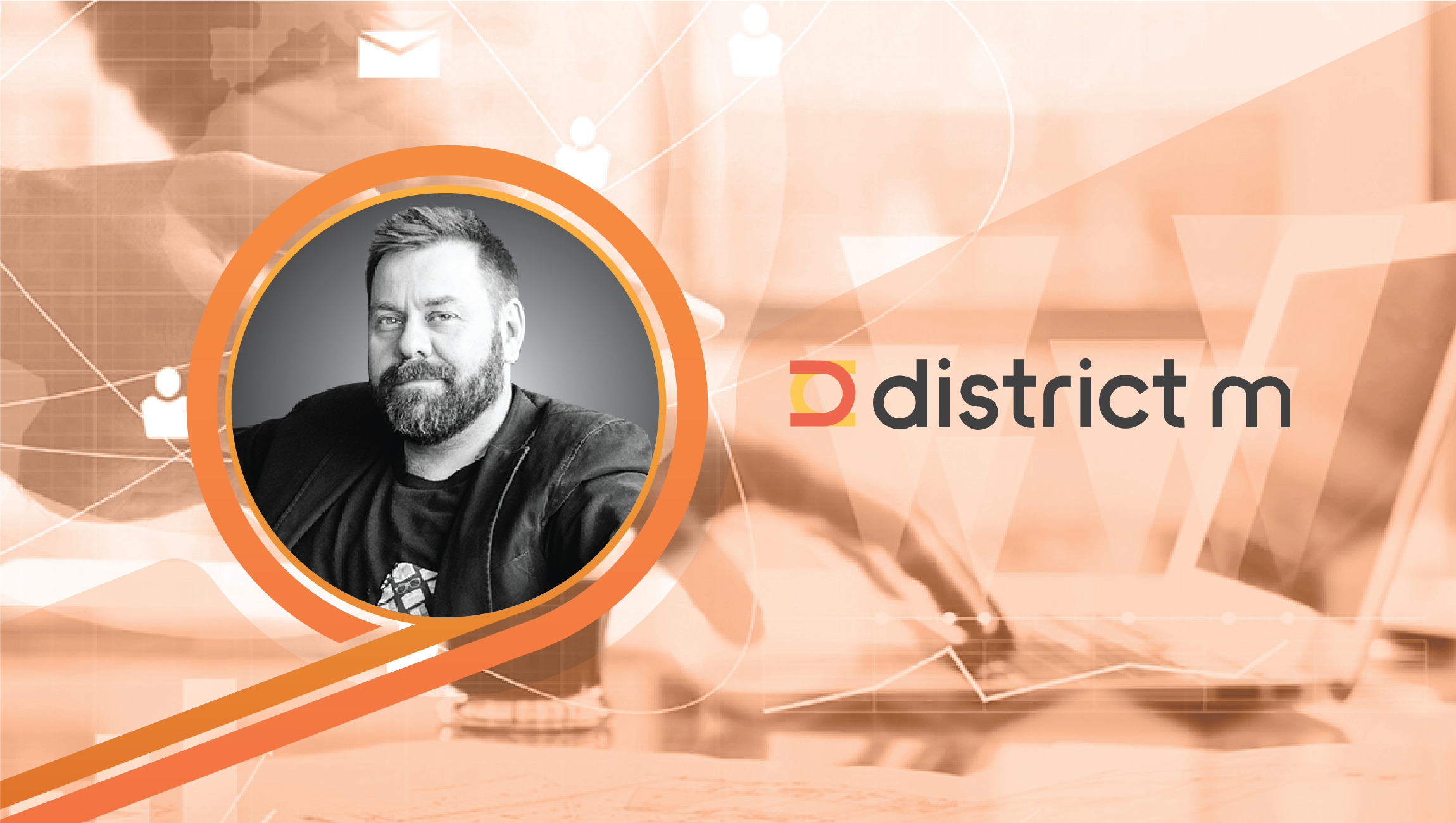Tell us about your role at district m? What inspired you to be part of an advertising technology company?
As CMO, my role includes all aspects of Marketing, from Brand Awareness to Demand Generation for the district m brand and sub-brands. I was offered the opportunity to take on this newly founded position early last year and the chance to build a fully-fledged marketing engine was just too good to miss. Add into the mix that digital advertising is core to any marketing strategy, being part of one of the leading ad tech innovators, was an easy decision for me to make.
Given the increasing focus on transparency and brand safety metrics, how should B2B businesses better leverage programmatic advertising technologies?
When it comes to topics like brand safety and transparency there are several considerations. Firstly, the vendor you work with needs to be your partner. This shouldn’t just be seen as a technology purchase, you will want to work with a specialist partner that can offer more than just a platform. Even if you are fully self-sufficient, working with a vendor that can offer you more support, insight, and services is key. They should themselves be open and transparent. Look at the different kinds of accreditations, guidelines, and associations to help on this, such as ads.txt or the IAB ad standards, these are in place to help with transparency and to reduce negative impact to the ultimate recipient of any campaign you want to deliver. Your programmatic partner should be part of these associations or openly adhere to these guidelines.
What are the tools and trends that are shaping the way advertisers and publishers achieve higher conversion rates?
Transparency and trust are clearly at the core, adhering to IAB and other advertising standards goes a long way to address conversion rate performance. But audiences are demanding more, they want less intrusive ads whilst at the same time more engaging ones. This is reflected by the creation of other associations like the ‘Coalition for better ads’and in the growing interest for DCO (Dynamic Content Optimization). A fine blend of all of these will mean that ads become subtle, yet visible, whilst being contextually relevant to the viewer and thus improve the acceptance of them and ultimately the conversion through them. There is definitely a fine balance between all of these factors, but, will be key to success through not just 2018, but way beyond.
How do audience data privacy norms impact the adoption of advertising technology platforms? How are you preparing for the GDPR era?
The evolution of data privacy is part natural progress, but also part of understanding the comfort dial. What is acceptable, what is too much, too intrusive and what is valuable or not to the recipient. Respecting data privacy is paramount, it is an obligation of any vendor in any industry to respect this. As these rules/requirements evolve, so must a vendor.
With an exploding B2B ad tech landscape, what are the major opportunities and challenges for CMOs to meet changing definitions of personalization and customer experience?
The explosion in ad tech is awesome. But the fundamentals still need to be there. Understanding where the new technologies fit into your marketing toolset should be done before going full speed in using them. The good news is that regardless of the ever-changing technology, your campaigns will always be there to achieve pretty consistent goals… Grab mindshare, generate new clients, retain existing ones. As new technology evolves, seeing where it can fit in and improve the results of your core goals for your business is what will maximize the opportunity.
The callout for personalization and customization comes from the need to put the audience experience and needs first. As a consumer, we have gone from wanting as much information as possible, to now needing to cut back on the noise and only wanting to see what is relevant at that given point in time.
Aligning the audience’s needs, and your business goals are critical to success, and having the right blend of solutions for your business will be the key for any CMO to achieve.
What startups are you watching/keen on right now?
There are a few Montreal-based businesses of course (our startup community here is extremely strong and supportive), that are exciting ones but if I have to name a couple, bus.com and Chronogolf come to mind, then on a wider scale, there are a lot of cryptocurrency and blockchain businesses that I am following. This is also a very interesting marketplace.
What tools does your marketing stack consist of in 2017?
Asana, Google portfolio of tools, SEM Rush, SEO Quake, and yes, we do use our own tools from Mypixel and district m.
How do you prepare for an AI-centric world as a marketing leader?
AI for me as a marketer is the next step from automation. It means we can explore more variables more quickly and become even more accurate with our predictions and decisions. As and where we can, we will use AI internally to help accelerate this process for us. Many articles that I have read in recent times around AI have an undertone of fear for job loss. For me it isn’t the case, it allows us to accelerate our insight, gives us the opportunity to evaluate many paths (some of which we don’t even have the time to think of), serve us with even more options and ideas. It really is quite exciting.
One word that best describes how you work.
Diverse
What apps/software/tools can’t you live without?
Email, Slack, Whatsapp, Skype… communication tools J Asana, the Google portfolio, a ton of SEO and SEM tools
What’s your smartest work-related shortcut or productivity hack?
Anything that can be automated rather than manually done should be looked into. It may take a little bit of time to set up, but not having to worry about sending emails, notifications and such frees up a lot of time for other tasks!
What are you currently reading? (What do you read, and how do you consume information?)
I love reading, but get very little time to do so. Nowadays I rely on audiobooks during my commute. Recently I finished off a couple of books including ‘Influence’ by Robert Cialdini, great view into the psychology of why people say yes, and then ‘Evicted’ by Matthew Desmond, a truly eye-opening account written first hand by the author on the poorest neighborhoods in Milwaukee, the book captures the stories from 8 different families. A really well written and brilliant piece.
What’s the best advice you’ve ever received?
‘Measure twice, cut once’. This was from my father about woodwork when I was a young boy, but it’s a good rule that can apply to many things. In essence, for me, it means that you don’t rush into something without a double check. Definitely NOT second-guessing yourself or hesitating, but, it is easy to get caught up in the pace of getting things done quickly, so a double/sanity check (that may only take a few moments) is a good investment in time for solid business decisions.
Tag the one person in the industry whose answers to these questions you would love to read:
It’s got to be someone like Leslie Berland of Twitter. One of the top 50 in Forbes most influential CMOs.
Thank you Adrian! That was fun and hope to see you back on MarTech Series soon.
Experienced CMO with a demonstrated history of working in tech. Skilled in Search Engine Optimization (SEO), Search Engine Monetization (SEM), Sales, Management, Software as a Service (SaaS), and Direct Marketing. A strong marketing professional.

district m is a full-service advertising exchange that creates open, transparent marketplaces through which publishers and advertisers can quickly and easily connect to maximize today’s digital advertising demand. Since our inception, we have served as a trusted monetization partner to 2,500 publishers globally by bringing incremental demand through over 200 unique brand partnerships. With offices in New York, Montreal and Toronto, and propelled by an investment by Fonds de solidarité FTQ, we continue to grow and increase our footprint in the digital media industry. As of today, our company is comprised of more than 60 talented experts who are all responsible for its international success and influence.
The MTS Martech Interview Series is a fun Q&A style chat which we really enjoy doing with martech leaders. With inspiration from Lifehacker’s How I work interviews, the MarTech Series Interviews follows a two part format On Marketing Technology, and This Is How I Work. The format was chosen because when we decided to start an interview series with the biggest and brightest minds in martech – we wanted to get insight into two areas … one – their ideas on marketing tech and two – insights into the philosophy and methods that make these leaders tick.











